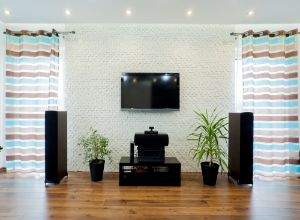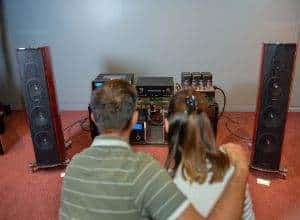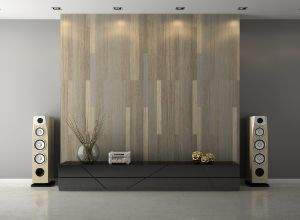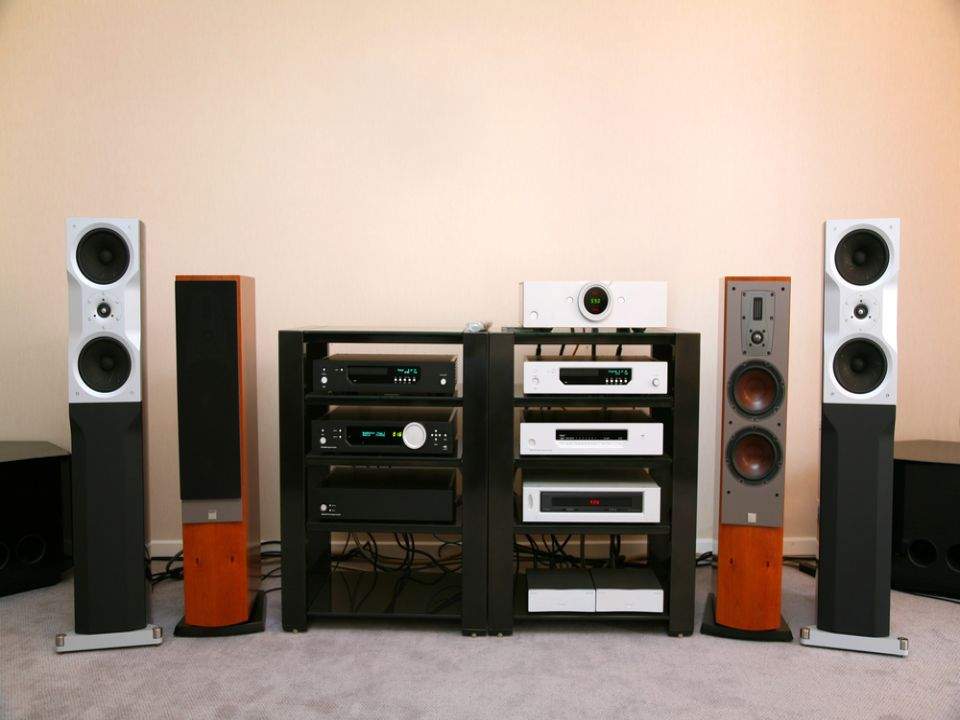The best way to elevate your movie and entertainment pleasure is to install the best home theater speakers in your space.
If you already have a large screen, you are halfway there, but unless the sound is fixed, you won’t experience the same thrills as a movie theater.
You may enjoy home theater audio if you can upgrade your speakers, get surround sound, add a subwoofer, or set up Dolby Atmos. Then you will find out that everything about watching a movie, a documentary, or a sporting event has changed.
It may take work to know where to begin. If you know a little about audio systems, it could be a tricky feat.

The good news is that you can quickly learn all you need about the best home theater speakers and some tips on maximizing their entertainment potential.
What Makes The Best Home Theater Speakers?
A home theater speaker system will send your TV’s sound back through a bigger set of speakers. It’s crucial to understand that there are several configuration options and speaker arrangements.
Home theaters often use surround sound, which disperses sound across your space to give you the immersive experience that you are in the middle of the action.
Installing the best home theater speakers in your home cinema is optional. However, some homeowners dislike the thought of their space being cluttered with several speakers and cords.
In such a situation, you can reach out to a reliable home theater installer company, like us at Custom Integrators, who can install a wireless speaker system in its place or a smaller speaker setup that does not use typical surround sound.
Installing better sound will always increase your experience of watching movies in your room, regardless of your preferred installation method.
What Kinds of Speaker Systems Are Available for Home Theaters?
If you want to experience the best home theater speakers, you must first understand the many methods for setting up home theater audio, regardless of whether you choose a full surround sound system or a more compact audio setup.
Home theater speakers may be installed in your space using one of three methods.
1. Speakers connected to a stereo amplifier or AV receiver
This is arguably the most versatile choice but also the most difficult to set up. You need a multichannel amplifier known as an AV receiver for surround sound. You only need a stereo amplifier if you are content with stereo sound.
You will need to purchase your home theater speakers separately for this option, either as a set or separately, and connect them to the amplifier using speaker wire. Passive speakers are those that need speaker wire to connect to an amplifier.
2. A complete home theater setup
Complete systems are the ideal choice for those looking for a simpler solution. The total package offered by all-in-one systems involves speakers and an amplifier. Frequently, you will also get all the required extras, such as speaker wire.
Of course, if you choose a fully wireless system, you won’t require a speaker cable. The main benefit of these systems is that you can only verify some of the parameters and match the speakers to the amplifier.
3. A Single Soundbar or System

Soundbars are the most recommended option for homeowners who wish to improve the sound in their space without adding several large speakers.
A cost-effective soundbar will quickly improve your TV’s sound that you may attach to it. Additionally, the space is kept clutter-free because it just has to be placed under your television.
Without an amplifier, most soundbars may be connected to your TV via an HDMI, optical, or stereo RCA connection.
These speakers are referred to as active speakers since they feature built-in amplification and don’t need an amplifier. Like the previously described all-in-one systems, bigger soundbar systems are also available.
These are still simpler to install than a full AV receiver and speakers configuration, even if they feature additional speakers, such as subwoofers and surround sound.
Speaker Information
To understand the elements of the best home theater speakers, you’ll need to understand speaker specifications first.
Power Management
The majority of speakers provide the recommended power range, which specifies the speaker’s ideal minimum and maximum amplifier power.
To ensure that you are within reason, you should verify the rated output of your amplifier. You don’t have to be precise, and there is plenty of room for error, but you should ensure that your amplifier and speaker are compatible.
Type and Size of Speakers
It’s helpful to have a broad grasp of the various varieties since the size and type of the speaker driver or cone are often specified.
Multiple drivers are often used in speaker designs to replicate certain frequency ranges. Each driver in the speaker cabinet receives a set of frequencies from the crossover, which filters the incoming audio signal.
A tweeter is a tiny speaker often used for reproducing high frequencies; it has a dome-shaped diaphragm around an inch in diameter.
A woofer is a speaker with a larger driver and a cone-shaped diaphragm for improved reproduction of low frequencies.
Speaker Audio Performance
This is where it becomes subjective, and what one person considers the best home theater speakers may not be so good to another.
The details mentioned above may give you a general notion of a speaker’s caliber, but hearing them is the only accurate method.
You’ll have to depend on the specs and the views of others if you can’t manage to hear the speakers for yourself.

You cannot go wrong with any of the speakers produced by the top companies since they all sound great. However, only you can determine if it adheres to your definition of “good.” Also, remember that the sound of a speaker will differ based on the amplifier being used and the space in which it is being utilized.
It shouldn’t come as a surprise if the more costly speakers sound better since you get what you pay for. Nevertheless, most individuals have modest budgets, and only you know how vital high-quality sound is to you.
Purchase the best home theater speakers available, and your speakers will endure daily wear and tear for many years.
What Qualities Should The Best Home Theater Speakers Have?
For an authentic surround sound experience, home theater speakers should function well together. The sound should be audibly full and clear from both the front and center speakers. The subwoofer should have a strong bottom end that blends well with the low-end frequencies supplied by the other speakers, and the surround speakers should effectively distribute the surround effects.
Tips On Getting The Best Home Theater Speakers
Mixing and matching brands are far from the audio ideal since not all surround-sound speakers are made equal. Consider the following advice when selecting the best home theater speakers:
1) If you have a 5.1 or a 7.1 system, get five or seven timbre-matched speakers. Although timbre matching is a rather sophisticated term, it essentially implies that the sounds produced by each speaker will be comparable. Your room’s sound should be consistent throughout. Although it’s the arrangement in most houses, there are better combinations than a tiny center-channel speaker from one brand and huge floor-standing speakers from a second manufacturer.
2) Bookshelf speakers 12 to 15 inches tall are a great choice for most individuals with a medium-sized living room or den. They come in practically every price range and are a practical size that won’t overpower a space. Bookshelf speakers often don’t provide much bass, but that’s OK since the subwoofer will handle those low frequencies.
3) Only a big multipurpose room or specialized home theater setup should include 38 inches or larger speakers. Although the loudest and best-sounding speakers in this price range can be, they are too much for most settings.
4) The subwoofer is a crucial component of the whole surround-sound setup. On CDs and DVDs, it reproduces the full power of the deep bass. However, most midrange systems include a woofer, a tiny driver housed in a tiny cabinet with a tiny amplifier. Deep bass won’t be audible on DVDs, but this is OK for music. Spend the money on a true subwoofer instead, which will produce deep bass thanks to its larger woofer driver, amplifier, and housing.

5) When getting speakers, some customers get fixated on power ratings or “wattage,” but such figures are only the manufacturer’s recommendation. Although it’s not required, utilize these ratings as a reference for selecting speakers at or above the amp’s wattage. For example, a 100-watt amp can be something other than 100-watt speakers.
Although all home theater systems and speakers come with cords, think about purchasing aftermarket cables. The wires will last longer without issues and provide superior video and audio.
Although some cables come with price tags that reflect their exaggerated performance promises, spending hundreds of dollars on excessively thick cables is optional. As a general guideline, the cables should cost between 10% and 15% of the entire cost of the home entertainment system. Gold-plated connectors are one item to look for. In contrast to nickel or tin-plated connections, which corrode and produce distortion, gold connectors won’t corrode.
With the plethora of options available, getting the best home theater speakers could be daunting. Luckily, we at Customs Integrators are here to help. We are professional home theater speaker installers and we know what the best home theater speakers are for your area size, budget, and preference. Reach out to us today!

